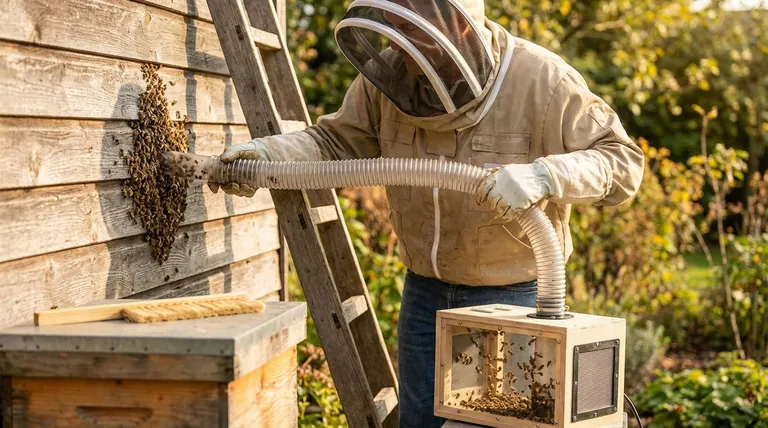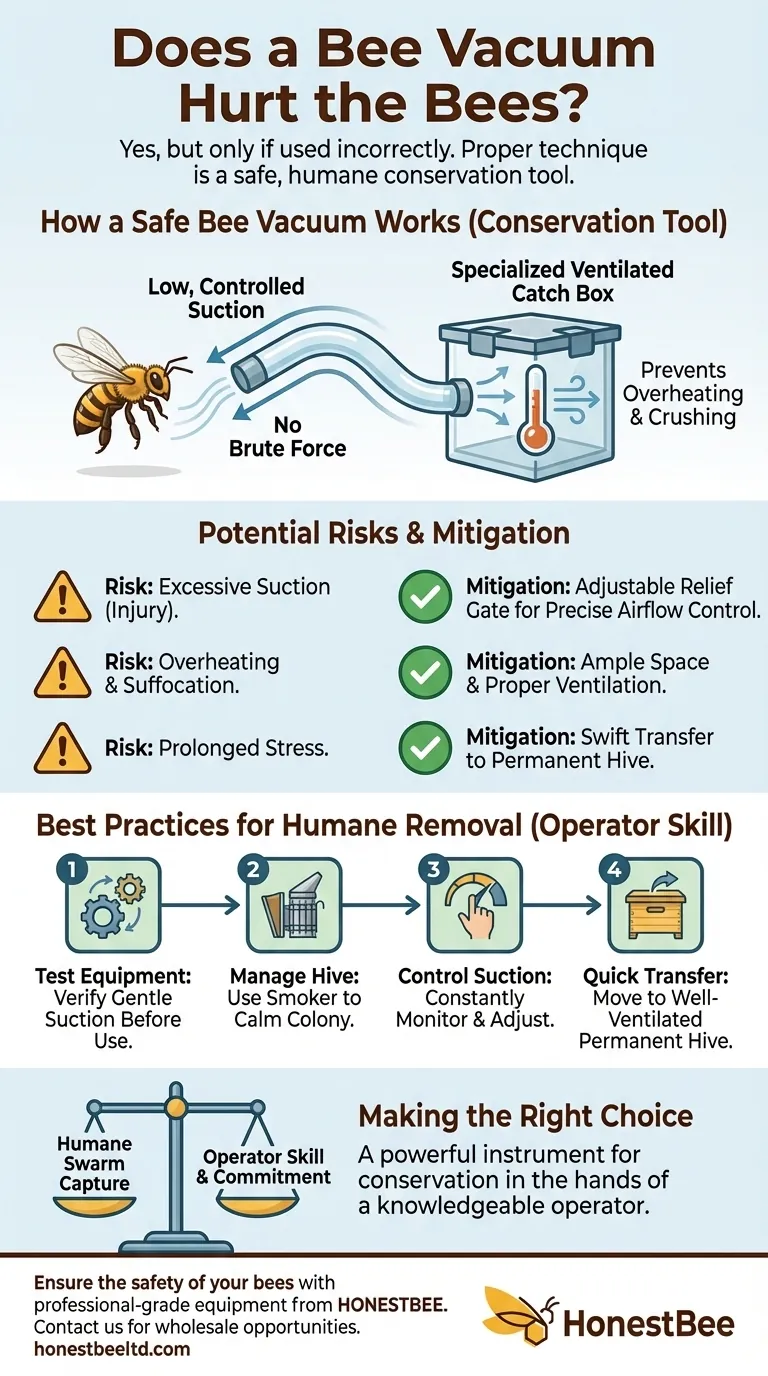When used correctly, a properly designed bee vacuum is one of the safest and most effective tools for relocating a honeybee colony. Its purpose is not to harm but to gently transport bees, especially from locations where other removal methods are impractical or more dangerous. The safety of the bees, however, is entirely dependent on the quality of the equipment and the skill of the operator.
The safety of a bee vacuum hinges less on the tool itself and more on the operator's technique. Proper suction control and immediate post-capture care are what separate a gentle relocation from a harmful one.

How a Bee Vacuum Works to Protect Bees
Understanding the design intent of a bee vacuum clarifies its role as a conservation tool, not an extermination device. It is built around the principle of moving bees with minimal stress.
Gentle Suction, Not Brute Force
A bee vacuum uses low, controlled suction. The goal is to generate just enough airflow to lift and carry a bee through a smooth hose into a collection box, not to violently pull it from a surface. This minimizes the risk of physical injury to their delicate wings and bodies.
The Importance of the Catch Box
Bees are not vacuumed into a simple bag. They are drawn into a specially designed catch box that has ample space and, most importantly, proper ventilation. This design prevents the two biggest post-capture risks: bees being crushed by the weight of other bees and overheating from a lack of airflow.
A Safer Alternative for Difficult Removals
For swarms or established colonies in challenging locations—such as wall cavities, chimneys, or high tree branches—a bee vacuum is often the least harmful option. Alternative methods could involve destroying property or using chemicals, making the vacuum a superior choice for preserving the colony.
Understanding the Trade-offs and Risks
While effective, a bee vacuum is a powerful tool that can cause harm if misused. Objectivity requires acknowledging these potential pitfalls.
The Danger of Excessive Suction
This is the number one cause of bee injury and mortality. If the suction is too high, bees can be slammed against the inside of the hose or the catch box, causing fatal injuries. Most quality bee vacuums have an adjustable relief gate to precisely control airflow.
The Threat of Overheating and Suffocation
A catch box full of thousands of bees generates a significant amount of heat. If the bees are left in the vacuum's collection chamber for too long, or if the chamber has poor ventilation, they can quickly overheat and suffocate. A swift transfer to a permanent, well-ventilated hive is critical.
Inevitable Stress and Minor Losses
Even with perfect technique, the process of being vacuumed and relocated is stressful for the colony. It is realistic to expect a very small percentage of bees may not survive the experience. The goal of a skilled operator is to keep this number as close to zero as possible.
Best Practices for Safe Bee Vacuuming
Mastering the use of a bee vacuum is about diligence and respecting the insects. Following established best practices is non-negotiable for a humane removal.
Test Your Equipment
Before approaching the colony, perform multiple tests to ensure the suction is set correctly. Practice on a few stray bees or a similar lightweight object to confirm the airflow is gentle enough to lift, not damage.
Manage the Hive Environment
Using a smoker to calm the bees before you begin can make the process smoother and less stressful for the colony. If possible, performing the removal in the evening when bees are less active can also be beneficial.
Control the Suction Level Constantly
Never assume the suction is correct. Continuously monitor the airflow and use the relief gate to make micro-adjustments as needed. Your goal is to use the absolute minimum suction required to move the bees.
Ensure a Quick and Cool Transfer
The vacuum's catch box is a temporary transport vessel, not a home. Transfer the bees to their new, permanent hive box as quickly as possible after capture to prevent overheating and allow them to reorient.
Making the Right Choice for Bee Relocation
Your decision to use a bee vacuum should be based on the situation and your commitment to using the tool properly.
- If your primary focus is humane swarm capture: A bee vacuum, used correctly, is a top-tier tool, especially for colonies in inaccessible locations.
- If you are a beginner: Prioritize learning proper suction control and hive management before attempting to vacuum a full, established colony.
- If you are facing a simple, exposed swarm: Shaking the bees into a box can be a simpler method, but a bee vacuum remains a reliable and safe alternative if you have the equipment and skill.
Ultimately, a bee vacuum in the hands of a knowledgeable operator is a powerful instrument for conservation, enabling the safe rescue of colonies that might otherwise be lost.
Summary Table:
| Factor | Impact on Bee Safety |
|---|---|
| Suction Control | Critical; low, gentle suction prevents injury. |
| Catch Box Design | Essential; proper ventilation prevents overheating. |
| Operator Skill | Paramount; correct technique ensures a safe transfer. |
| Transfer Speed | Important; quick movement to a hive prevents stress. |
Ensure the safety of your bees and the success of your relocations with professional-grade equipment from HONESTBEE.
Whether you are a commercial apiary managing large-scale operations or a beekeeping equipment distributor, our wholesale-focused supplies are engineered for efficiency and bee welfare. From gentle bee vacuums to durable hive components, we provide the reliable tools you need.
Let's discuss your specific needs. Contact our team today to learn more about our products and wholesale opportunities.
Visual Guide

Related Products
- Double Row Artificial Fiber Bee Brush for Beekeeping
- HONESTBEE Professional Long Handled Hive Tool with Precision Cutting Blade
- HONESTBEE Advanced Ergonomic Stainless Steel Hive Tool for Beekeeping
- Professional Dual-End Stainless Steel Hive Tool for Beekeeping
- Plastic Handle Single Row Artificial Fiber Bee Brush
People Also Ask
- How are bees dislodged from frames? Master the Shaking Technique for Efficient Colony Transfers
- Why is a bee brush important? Essential for Gentle, Safe Hive Management
- Is a bee brush used to harm bees? Learn the Proper Tool for Gentle Beekeeping
- How does using a bee brush benefit beekeepers and the hive? Achieve Gentle, Stress-Free Hive Management
- What are the key features of a popular bee brush? Essential Design for Bee Safety and Hive Hygiene



















